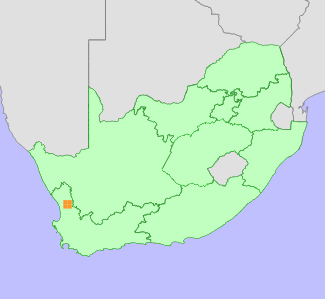|
Scientific Name | Babiana toximontana J.C.Manning & Goldblatt |
Higher Classification | Monocotyledons |
Family | IRIDACEAE |
National Status |
Status and Criteria | Endangered B1ab(ii,iii,iv,v)+2ab(ii,iii,iv,v) |
Assessment Date | 2021/03/18 |
Assessor(s) | N.A. Helme, L. von Staden, D. Raimondo & T. Patel |
Justification | This species has an extent of occurrence (EOO) of 175 km², and an area of occupancy (AOO) of 36 km². It is known from five locations. Subpopulations on sandy flats are threatened by habitat loss as a result of expanding Rooibos tea cultivation. It is therefore listed as Endangered under criterion B. |
Distribution |
Endemism | South African endemic |
Provincial distribution | Western Cape |
Range | It is a local endemic of the foothills of the Matsikamma and Gifberg Mountains between Klawer and Vanrhynsdorp in the Western Cape, South Africa. |
Habitat and Ecology |
Major system | Terrestrial |
Major habitats | Klawer Sandy Shrubland, Vanrhynsdorp Gannabosveld, Bokkeveld Sandstone Fynbos |
Description | It occurs in arid fynbos on sandy flats and stony lower slopes. |
Threats |
| this species has lost 84% of its habitat (calculated using landcover data in GIS). In the past the habitat of this species was occasionally ploughed for cash crop cultivation. Rainfall in the area is very unreliable and it is only marginally suitable for agriculture. However, farmers do occasionally plough deeper sandy areas on the flats for the cultivation of cash crops in years of good rains, but the rest of the time fields are left fallow and grazed by livestock. This species may be able to recolonize old fields and subpopulations in rocky areas are unlikely to be threatened.
Recently, however, more and more of the deep sandy soils have been planted with Aspalathus linearis, a hardy perennial that is the source of Rooibos tea. This is causing ongoing irreversible habitat loss (N. Helme pers. comm.). |
Population |
A note from a 2014 records indicate that this species is uncommon in Fynbos and Succulent Karoo. There is not much known about the population of this species, and it requires monitoring. However, the population decline is inferred from ongoing habitat loss.
|
Population trend | Decreasing |
Conservation |
| It is not formally protected. |
Assessment History |
Taxon assessed |
Status and Criteria |
Citation/Red List version | | Babiana toximontana J.C.Manning & Goldblatt | EN B1ab(ii,iii,iv,v)+2ab(ii,iii,iv,v) | Raimondo et al. (2009) | |
Bibliography |
Goldblatt, P. and Manning, J.C. 2007. A revision of the southern African genus Babiana, Iridaceae, Crocoideae. Strelitzia 18:1-97. South African National Biodiversity Institute, Pretoria.
Goldblatt, P. and Manning, J.C. 2020. Iridaceae of southern Africa. Strelitzia 42. South African National Biodiversity Institute, Pretoria.
Raimondo, D., von Staden, L., Foden, W., Victor, J.E., Helme, N.A., Turner, R.C., Kamundi, D.A. and Manyama, P.A. 2009. Red List of South African Plants. Strelitzia 25. South African National Biodiversity Institute, Pretoria.
|
Citation |
| Helme, N.A., von Staden, L., Raimondo, D. & Patel, T. 2021. Babiana toximontana J.C.Manning & Goldblatt. National Assessment: Red List of South African Plants version 2024.1. Accessed on 2025/10/17 |
 Comment on this assessment
Comment on this assessment


